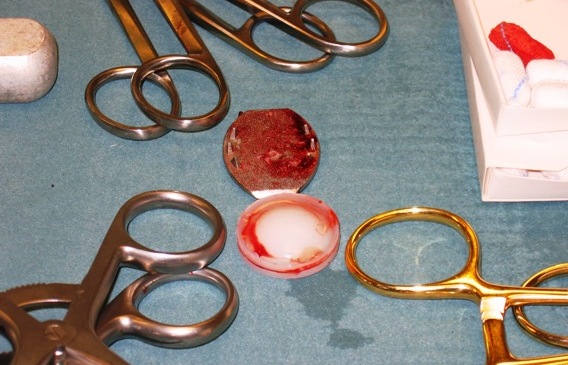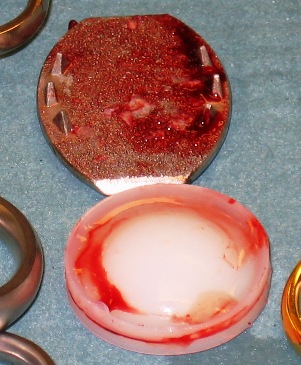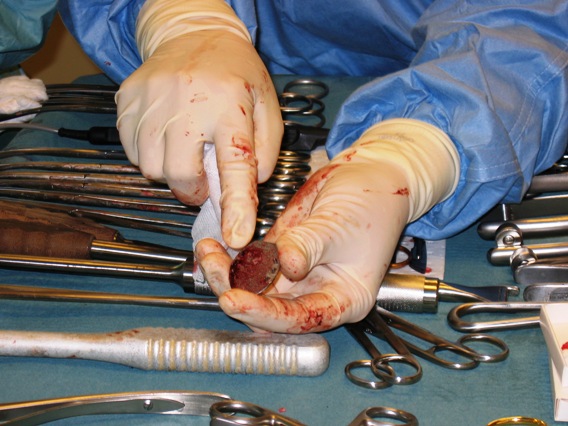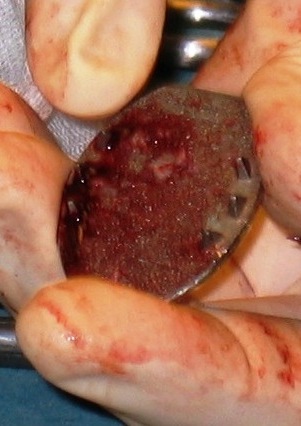 |
||
|
|
|
|||||||
| iSpine Discuss Keel slot process in the Main forums forums; mark please explain the keel slot cutting process. from my understanding they are cut at the same time or before ... |
 |
|
|
LinkBack

|
Thread Tools

|
Display Modes

|
|
|||
|
thanks very much for a very detailed expaination
now is the keel a press fit or does it slide easly into the slot? chuck
__________________
ddd 1990 2003 mri,xrays,shots,emg 2004 discogram ouch pos l4 l5 facet block neg lost all appeals BCBS 5 months of that 3 surgeons later surgery with dr. bertagnoli aug 2nd 2006 in Bogen Germany Successfully ProDisc-L L-4 L-5 |
|
||||
|
Chuck,
I believe that it is a press fit for several reasons, however, I've not personally felt the resistance, so I don't know how tight it is. When they talk about fixation or integration of a prosthesis, they talk about primary and secondary fixation. Primary fixation is what you have on implantation. Secondary fixation is what you get after osteointegration of the device. I believe that all of the coated metal devices will achieve excellent secondary fixation. I was in on Mr. Bee's revision surgery at Stenum to revise the undersized, poorly located and subsided Charite'. The revision took place at 10 weeks post-implantation. I got to see, first-hand, how tightly the plates had adhered to the vertebral bodies. You could see the bone that was grown into the coating at just 10 weeks. Pictures included below with Mr. Bee's permission. The strongest primary fixation comes when you seriously attach the device to the bones. The old Bristol cervical disc with a flange and 2 screws at each level provides the most primary fixation I've seen in ADR. Now, Medtronic still opts for primary fixation, but has dropped one screw per level, so they don't interfere with potential multi-level procedures. A keel provides more primary fixation because of all the surface area of the keel, adds to the total surface area that provides friction or surface tension that will resist migration. A loose fit would not provide as much primary fixation as a tight fit. Also, for it to be a loose fit, the keel cutter would have to chisel a slot that is wider than the keel. No motivation to do that. It would also increase the risk of damaging the body to use a very wide chisel. So opening the slot with a chisel, then opening just a little more with the keel. I'm going to the NASS meeting Wendesday through Saturday. I'll look at the tools and talk it over with some of the surgeons. If I learn more, I'll post it here. Mark PS... sorry that this went from a question about the keel into fixation, but that is what the keel is about. Charite' explanted at 10 weeks. See bony ingrowth. They were very strongly adhered to the vertebral bodies.     Last edited by mmglobal; 09-23-2006 at 06:29 PM. |
|
|||
|
thanks mark
that makes sence in which the keel surface area adds to total sq inches involed for secondary fixation. chuck
__________________
ddd 1990 2003 mri,xrays,shots,emg 2004 discogram ouch pos l4 l5 facet block neg lost all appeals BCBS 5 months of that 3 surgeons later surgery with dr. bertagnoli aug 2nd 2006 in Bogen Germany Successfully ProDisc-L L-4 L-5 |
|
||||
|
Just from a design point of view, I'm not sure I understand the motivation to go with holes in the keel. It reduces the surface area. Potentially, bone grown into the hole will take more with it on the way out if explantation is required????
Any of you engineer types care to speculate? Mark |
|
|||
|
prodisc has holes?
one would think the holes are there for mfg proposes or that they are trying to get bone to grow thru the holes. or sometimes additional holes are needed durning the machining process.
__________________
ddd 1990 2003 mri,xrays,shots,emg 2004 discogram ouch pos l4 l5 facet block neg lost all appeals BCBS 5 months of that 3 surgeons later surgery with dr. bertagnoli aug 2nd 2006 in Bogen Germany Successfully ProDisc-L L-4 L-5 Last edited by chasswen; 09-23-2006 at 07:07 PM. |
|
||||
|
No, Prodisc keel is a fin... no holes. Kineflex and Maverick have holes. That's a Kineflex in the center of the iSpine header (currently). See holes in Keel. Activ-L on the right has no holes. Mobidisc has no holes, but there is a gap between the keel and endplates that may create a similar issue.
Mark |
|
|||
|
interesting must be a very fine line of how much of a press fit due to the stresses that would be created on the vertbra.
neat stuff one would think that any device with a keel surely would stay in place all by its self due to the muscle and weight of the upper body. as the charite only has small teeth for a anchor. chuck
__________________
ddd 1990 2003 mri,xrays,shots,emg 2004 discogram ouch pos l4 l5 facet block neg lost all appeals BCBS 5 months of that 3 surgeons later surgery with dr. bertagnoli aug 2nd 2006 in Bogen Germany Successfully ProDisc-L L-4 L-5 |
|
|||
|
if needed they fuse the area with the disc in place.
prodisc can be revised early on per dr. b chuck ps mark would be able to do alittle better with a anwser
__________________
ddd 1990 2003 mri,xrays,shots,emg 2004 discogram ouch pos l4 l5 facet block neg lost all appeals BCBS 5 months of that 3 surgeons later surgery with dr. bertagnoli aug 2nd 2006 in Bogen Germany Successfully ProDisc-L L-4 L-5 |
|
||||
|
There was much talk about revisions at NASS. One session included a discussion about revisions and revision approaches by Dr. Salvador Brau. He's one of the top ADR approach surgeons who works with both Regan and Delamarter. Bertagnoli also presented 2-5 year results during this session and participated in a wonderful discussion about revisions.
I know that Bertagnoli has revised Charite to ProDisc. He has also revised ProDisc to another ProDisc. The original implantation was not his... a subsided, undersized ProDisc-L was replaced by a properly sized and placed ProDisc, using the same keel slot. Note that the vertebral body was not destroyed in removing the ProDisc. Dr. Brau has removed ProDiscs and Charite's... some many months after implantation. In anterior surgery, a serious problem is the inability to mobilize the great vessels so you have enough room to remove the prosthesis straight out the front. With a Charite' you can remove the core, then remove the plates individually, from an oblique angle... they do not have to come straight out the front. With a ProDisc, you can also remove the core separately. Once that is done, the plates can be broken loose individually. There must be enough distraction applied to allow you lift the plate enough to clear the keel. Once that is done, the plate can be removed from an oblique angle. The short keel of the ProDisc lends itself well to easy removal... even at L4-5 - the problem level. (The bifurcation of the great vessels makes this level the toughest to deal with.) I asked Dr. Brau to comment on his L4-5 ProDisc removal and speculate about removing a Maverick. Note that a Maverick does not have a core to remove. It will not be possible to apply enough distraction to clear the keels and remove a Maverick from an oblique angle. It can be impossible to mobilize the great vessels enough to allow the prosthesis to be slid forward - straight out the keel slots. If this is the case, the vertebral bodies will need to be seriously damaged to get the device out. Mark |
|
||||
|
Michelle, I should probably answer your specific question.
Explanting the device is a pretty extreme measure. In the first few years I was researching ADR, it was cavalierly said, "you can try ADR and if it doesn't work, you can always do a fustion!" As more and more people got disc replacements and we started to see revisions, it became clear that the cavalier, "just pop-em out and do a fusion" is a little understated. If you need revision surgery, whether it's from fusion, ADR or any other spine surgery, you are in trouble. However, as we learn more revisability becomes more paramount. Even for the ADR's that can be removed obliquely, like the Charite', there is high motivation not to explant the prosthesis. For most failure modes, fusion will mean adding posterior instrumentation - pedicle screws and rods... leaving the ADR as an interbody spacer. More and more, we are talking about adding motion preserving posterior hardware, instead of just fusing... but the jury is still out on this as experience is very limited. Also, each case is something of a one-of-a-kind surgery. If the prosthesis must be removed, then there is a big difference from one device to the next. As mentioned above, an all metal device with a tall keel will be difficult or impossible to explant without destroying a vertebral body. Next most invasive will be a keeled device with a tall keel and a poly core. If the keel is short enough to clear the keel without too much distraction, the keel is not an issue. Then, short keel devices... then no-keel devices. Revisions without fusion may be possible... but as I said above... each surgery is a one-off. Mark |
 |
| Bookmarks |
|
|